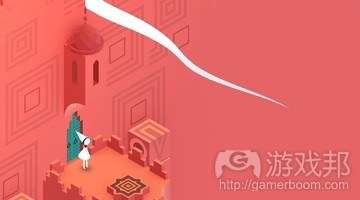《纪念碑谷2》是如何利用游戏机制表达感人故事
《纪念碑谷2》是如何利用游戏机制表达感人故事
原作者:Alissa McAloon 译者:Willow Wu
就如前作一样,Ustwo Games的《纪念碑谷2》是一款视觉冲击力极强的解谜游戏,玩家要帮助游戏的主人公在极其抽象的环境中找到唯一的出路。这次,开发团队想用续作来补充一些前作没能展现的东西。
在今年的GDC上,Ustwo Games的游戏设计师Lea Schonfelder表示他们想保留《纪念碑谷》的游戏特色,在此基础上进行提升。在视觉上,他们想让游戏的每一帧都像是一幅艺术作品,就像是前作那样,但会更加精美。Schonfelder说这些设计难度极高的M.C. Escher式几何图形就是《纪念碑谷》世界的精髓,他们想要在第二部中继续研究这些谜题。
游戏的第一部讲述了一个惹人喜爱的故事,Ustwo Games想在续作中呈现一个更加有深度的故事。这个故事究竟会是怎样的?Schonfelder说他们思考了一个关于原谅、自由、认可、骄傲或者是信任的故事。在进行权衡的时候,他们逐渐明白这些元素都能融入到同一个故事中去。
Schonfelder说:“我们问自己,如果这些情感变化都出现在同一种关系呢?” 从这以后,一个母亲和她孩子之间的故事就开始了。
相比用对话或者是文字呈现剧情,《纪念碑谷2》用的是色彩、关卡设计和变化的游戏机制来体现母亲和孩子在整个游戏过程中的内心挣扎以及成长。
Schonfelder说“我们不想用寻常的方法插入剧情,我们的目标是把游戏当成媒介,让玩家通过游戏机制感受游戏本身。”
举个例子,在游戏前期,女儿和妈妈是可以一起移动的,但是后来发生了突发事件——路塌了,她们不得不分开走。当玩家控制妈妈的时候,她的女儿被困在另一个平台上,尝试着接近她的妈妈。提到这个突然的意外,Schonfelder解释说这象征着角色的各自变化,同时又引导了玩家如何利用孩子的跟随属性,而这一切都不需要任何文字表达或者是直白地跟玩家解释这是在干什么。
虽然妈妈可以很容易达到通关大门,但是玩家们凭直觉就能明白在去往下一个关卡之前母女必须汇合,这是因为经历了之前的章节,这种母女之一体化的羁绊已经深深烙印在玩家心中。
在团聚之后,玩家仍要使用这种新的行动方式。孩子要面对一个新情景,她开始独立探索,而且这种独立行动所产生的自信感还会持续增长。直到母女二人来到了一个不得不分别的时刻,她们必须分头行动了。
从这一刻开始,《纪念碑谷2》的故事就产生分支了。对于母亲来说,她的旅程变成了一个自我反思的过程,女儿踏上了通往成年的道路,这是一条光明而又积极的路,而她则需要探索母亲之外的意义。Schonfelder解释说,两边的关卡设计都会有很大变化,来强调故事进入了新的章节。
“两个角色都在经历转变,她们要成为更加独立的人,”团队巧妙地通过视觉隐喻来呈现两个角色的旅程,如果你把两边的画面对比着看会觉得相当明显——母亲的世界突然变成了灰色调,而女儿的世界是色彩明亮、充满活力的。Schonfelder播放了一段从各个关卡剪辑而来的音乐,解释了他们是如何利用音乐来表现出母女二人的不同心路历程。
颜色、声音以及关卡设计都在向玩家传达角色的当前心态。Schonfelder用母亲的旅程举例,最终,母亲通过自我反思对自己有了新的认识,这些关卡中的螺旋设计就直接地隐喻了自身的内在探索。
在另一边,女儿的旅程氛围由乐观向上转为沉寂,因为她正面临着独立行动所带来的困难。但是在单人旅程的结尾,她从一朵花中走出来,成为了一个大人,就如Schonfelder字面所说的,一个含苞待放的女孩成年了。
Schonfelder说:“把这些设计都融入到剧情中去,我们就要思考如何使用这些隐喻来表达角色的情感以及游戏的基调,”
她说游戏关卡之间的那些文字确实是对剧情有锦上添花的作用,但这些文字是后来才增加的,因为他们刚开始很担心游戏会过度依赖文字表述剧情。
使用那些“讲故事”的场景确实能让玩家更容易、更直接地了解相关剧情,但是团队刻意避开了这种设计,《纪念碑谷2》一定要让玩家通过玩法本身了解剧情。
Schonfelder总结道:“相较于其它媒体形式,游戏可以用不同方式传达剧情,它们不一定要用文字。故事没有固定表达方式,反之有很多不同、有趣的技巧可以探索。”
本文由游戏邦编译,转载请注明来源,或咨询微信zhengjintiao
Like its predecessor, Ustwo Games’ Monument Valley 2 is a visually striking puzzle game in which players help its protagonist navigate an impossible arrangement of abstract environments, but the development team wanted to use the sequel as an opportunity to elaborate beyond what the first game had presented.
Speaking at GDC 2018, Ustwo Games game designer Lea Schonfelder said that the team wanted to retain but improve on key features of the first Monument Valley. Visually, they wanted every moment of the game to look as if it could be a piece of artwork, just as they had with the original game but this time with less of a 2014 feel. For individual levels, Schonfelder said that the impossible, M.C. Escher-like geometry was the heart of the Monument Valley world, and the team wanted to continue to explore those puzzles for the second game.
While the original Monument Valley told an endearing story on its own, Ustwo Games wanted to tell an even deeper story in the follow-up game. When trying to figure exactly what that deeper story would be, Schonfelder said the team considered a tale of forgiveness, freedom, acceptance, pride, or trust. But as they weighed the options, it started to become clear that all were elements of the same story.
“We started asking ourselves, what if all these variations were part of the same relationship?” said Schonfelder, and from there the story of the relationship between a mother and her child started to take form.
But rather than tell that story through dialog or text, Monument Valley 2 uses color, level design, and changing mechanics to portray the internal struggles and growth felt by each character as their relationship evolves throughout the game.
“The team didn’t want to add the story by usual methods,” explained Schonfelder. “The goal was to leverage games as a medium and allow the player to feel the game through its mechanics.”
For example, early on the mother and daughter characters move as one unit throughout levels, but after being forcefully separated by a crumbling walkway that abruptly changes. While players still have control of the mother, the daughter is stranded on a separate platform and follows from a distance to try and get as close to her parent as possible. This abrupt change, explained Schonfelder, served both symbolize a change in each character’s role and teach players how the child’s follow mechanic worked without using text or an explicit explaination.
Though the exit level door is clearly within the mother’s reach after that separation, Schonfelder explained that players still instinctively knew that the mother and daughter must be reunited before exiting the level, simply because of the emotional weight that had been placed on their cohesive movement during the early parts of the game.
Even after being reunited, the new movement mechanic remains as the child starts to explore the newfound independence that was suddenly introduced to her in the previous level, and that confidence continues to grow (and the dynamic continues to change) until the pair reaches a point in their lives where they must go their separate ways.
At that point, the story of Monument Valley 2 branches out. For the mother, her journey has become a self-reflective arc about discovering meaning beyond motherhood while the daughter embarks on a bright and optimistic journey into adulthood. In both cases, Schonfelder explained, level design elements change drastically to reinforce the new stories being told.
“Both characters experience a transformation and develop from their old roles into an individual,” said Schonfelder. The artful way the team used visual metaphors to explain each character’s journey is especially apparent when looking at the scenes side by side; grayscale dominates the mother’s suddenly colorless world while the daughter’s environments are bright and vibrant. Schonfelder played a clip of audio from each level as well, explaining how vastly different sounds were used for each to drive home the emotional journey being experienced.
As each progresses through their individual arcs color, audio, and level design continue to inform the players of that character’s current state of mind. Schonfelder used the mother’s journey as an example of this during her talk. Eventually, as the mother looks toward self-reflection to rediscover herself during her journey, the levels themselves mirror spirals as a very literal metaphor for the process of looking within one’s self.
Meanwhile the daughter’s journey progresses from bright and optimistic to more muted tones as she is confronted with the difficulties solo living entails. But at the end of her individual journey she emerges from a flower as an adult, as Schonfelder says literally blossoming into adulthood.
On the left, the child’s early solo journey with the mother’s first moments alone on the right.
“Working this into the story meant thinking about how we could use these metaphors that were already present for the mood and tone of the story,” said Schonfelder.
She noted that the game does have some instances of text that compliment the story, provided as interludes between levels, but that those were a late addition to the game as the team was initially worried they’d lean too heavily on text to tell a story.
Using those small ‘storyteller’ scenes, she explains, does give the player a more direct message about the story but the team consciously designed Monument Valley 2 in a way where that information is communicated through gameplay first and foremost.
“Games can tell story differently than other media; they don’t necessarily need written words,” closed Schonfelder. “There’s no one right way to do it, but there are different interesting techniques to explore.”(source:gamasutra.com )








































 闽公网安备35020302001549号
闽公网安备35020302001549号